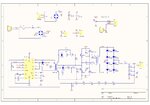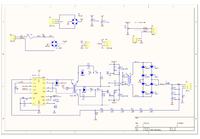arkanwe
Junior Member level 1
Hello, thank you very much for the comments!
Another try, here is the schematic:

If that doesn't work, here is another link:

ta-daaaa
Thanks mtwieg for pointing out the fact that the transistors are getting warm with low power at the output. Maybe it's necessary to tune better the snubber network. I know the -first- gate circuit was terribly bad!, that's because I've started the thread. The second one, is in the schematic here uploaded, and also tested. I don't know if it's soooo bad. I tried to copy one from a atx power source.
Yes you're right with the topology, I didn't use the forward converter because the power transformer has 3 windings. I thought it's more difficult to calculate and to build that transformer than the drive circuit. But, oh well, now I'm stuck with this.
And in the flyback, not sure, but I've read that the max voltage across the transistor is Vin+Vout×(Np/Ns) = 311+1000*0.25=561V, plus the overshoot, to me it was like to much voltage.
Well, didn't have time to try anything yet. I'll try the gap on the power transformer(pot core from epcos) and tune better the snubber network. Not sure what to do with the gate driver.
Best regards to all, have a nice time, bye!
Another try, here is the schematic:

If that doesn't work, here is another link:

ta-daaaa
Thanks mtwieg for pointing out the fact that the transistors are getting warm with low power at the output. Maybe it's necessary to tune better the snubber network. I know the -first- gate circuit was terribly bad!, that's because I've started the thread. The second one, is in the schematic here uploaded, and also tested. I don't know if it's soooo bad. I tried to copy one from a atx power source.
Yes you're right with the topology, I didn't use the forward converter because the power transformer has 3 windings. I thought it's more difficult to calculate and to build that transformer than the drive circuit. But, oh well, now I'm stuck with this.
And in the flyback, not sure, but I've read that the max voltage across the transistor is Vin+Vout×(Np/Ns) = 311+1000*0.25=561V, plus the overshoot, to me it was like to much voltage.
Well, didn't have time to try anything yet. I'll try the gap on the power transformer(pot core from epcos) and tune better the snubber network. Not sure what to do with the gate driver.
Best regards to all, have a nice time, bye!

